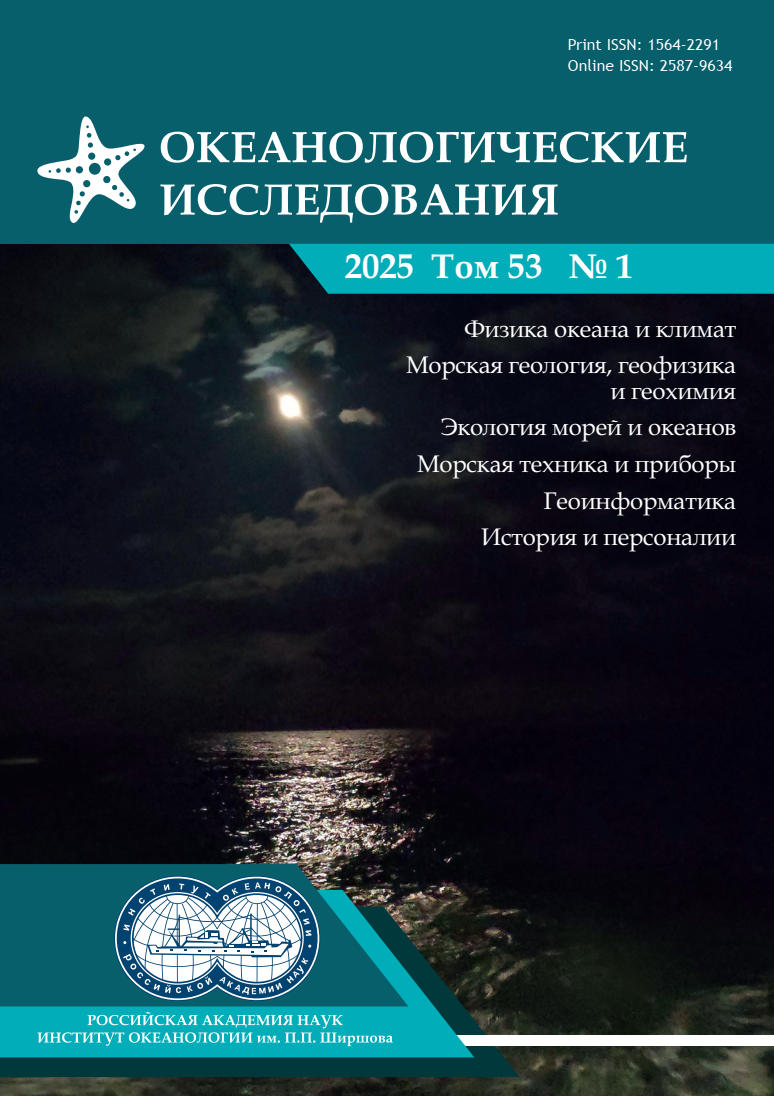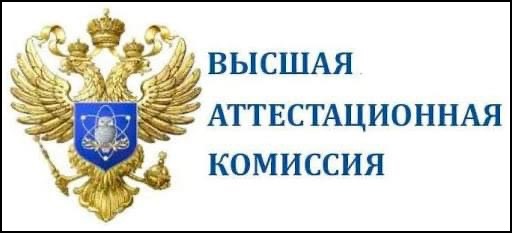СРАВНИТЕЛЬНЫЙ АНАЛИЗ ТИПОВ ПРИБРЕЖНЫХ ВОД ПО ДАННЫМ ПАССИВНОГО ОПТИЧЕСКОГО ЗОНДИРОВАНИЯ
Аннотация
Для характеристики и сравнения различных прибрежных районов морей, включающих плюмы рек и зоны смешения вод в проливах, предложена методика расположения их на специальной диаграмме (Диаграмме типов вод). Здесь выделяются зоны вод, близких по составу к океаническим водам, а также воды с избытком взвешенных веществ и/или с избытком растворенного органического вещества. При этом есть возможность проводить сравнение процессов в водах различной трофности. В работе приведены расчеты по данным пассивного оптического зондирования с борта судна для открытого океана, Черного моря, Керченского пролива, Карского моря и плюма реки Рио-Гранде у Бразильского побережья Атлантического океана.
Литература
- Гончаренко И. В., Ростовцева В. В., Коновалов Б. В. Использование нового судового комплекса пассивного оптического зондирования для получения распределения естественных примесей в прибрежных водах // Фундаментальная и прикладная гидрофизика. 2018. Т. 11. № 3. С. 97–101. https://doi.org/10.7868/S20736673180300127.
- Гончаренко И. В., Ростовцева В. В. Пассивное оптическое зондирование речных плюмов с борта судна с помощью гиростабилизированного комплекса ЭММА // Фундаментальная и прикладная гидрофизика. 2020. Т. 13. № 2. С. 96–102. https://doi.org/10.7868/S2073667320020124.
- Дроздова А. Н., Пелевин В. В., Крылов И. Н., Стрельцова Е. А., Коновалов Б. В. Растворенное органическое вещество поверхностного слоя воды Геленджикской бухты в сентябре 2021 года по данным флуориметрии и лидарных измерений // Океанология. 2022. Т. 62. № 6. С. 878–886. https://doi.org/10.31857/S003015742206003X.
- Зацепин А. Г., Завьялов П. О., Баранов В. И., Кременецкий В. В., Недоспасов А. А., Поярков С. Г., Очередник В. В. О ветровом механизме трансформации линзы опресненных речным стоком вод в Карском море // Океанология. 2017. Т. 57. № 1. С. 5–12. https://doi.org/10.7868/S0030157417010221.
- Коновалов Б. В., Кравчишина М. Д., Беляев Н. А., Новигатский А. Н. Определение концентрации минеральной взвеси и взвешенного органического вещества по их спектральному поглощению // Океанология. 2014. Т. 54. № 5. С. 704–711. https://doi.org/10.7868/S0030157414040066.
- Маккавеев П. Н., Стунжас П. А., Хлебопашев П. В. О выделении вод Оби и Енисея в распресненных линзах Карского моря // Океанология. 2010. Т. 50. № 5. С. 740–747.
- Маккавеев П. Н., Полухин А. А., Костылева А. В., Проценко Е. А., Степанова С. В., Якубов Ш. Х. Гидрохимические особенности акватории Карского моря летом 2015 г. // Океанология. 2017. Т. 57. № 1. С. 57–66. https://doi.org/10.7868/S0030157417010087.
- Матюшенко В. А., Пелевин В. Н., Ростовцева В. В. Измерение коэффициента яркости моря трехканальным спектрофотометром с борта НИС // Оптика атмосферы и океана. 1996. Т. 9. № 5. С. 664–669.
- Осадчиев А. А. Речные плюмы. М.: Научный мир, 2021. 288 с.
- Пелевин В. Н., Ростовцева В. В. Оценка концентрации светопоглощающих и светорассеивающих веществ в различного типа водах открытого океана // Оптика атмосферы и океана. 1997. Т. 10. № 9. С. 989–995.
- Пелевин В. Н., Попов А. К., Ростовцева В. В. О спектральной яркости моря вблизи Антарктиды и возможности дистанционного определения концентрации хлорофилла и «желтого вещества» // Материалы VI Международной Научно-технической Конференции МСОИ. Москва, 2000. С. 243–254.
- Ростовцева В. В. Метод получения спектров поглощения морской воды по данным пассивного дистанционного зондирования с борта судна с использованием свойств чистой воды // Оптика атмосферы и океана. 2015. Т. 28. № 11. С. 1003–1011. https://doi.org/10.15372/AOO20151107.
- Ростовцева В. В., Гончаренко И. В., Коновалов Б. В., Алюкаева А. Ф. Оперативная оценка состояния прибрежных морских акваторий по данным пассивного оптического зондирования поверхности воды с борта судна // Оптика атмосферы и океана. 2017a. Т. 30. № 12. С. 1017–1022. https://doi.org/10.15372/AOO20171203.
- Ростовцева В. В., Коновалов Б. В., Гончаренко И. В., Хлебников Д. В. Способ оценки содержания примесей в морских водах с помощью оперативной спектрофотометрии // Океанология. 2017b. Т. 57. № 4. С. 560–574. https://doi.org/10.7868/S0030157417040050.
- Ростовцева В. В., Ижицкий А. С., Коновалов Б. В. Определение характера смешения азовоморских и черноморских вод в Керченском проливе по данным комплексных дистанционных и контактных измерений // Океанологические исследования. 2022. № 50 (3). С. 70–87. https://doi.org/10.29006/1564-2291.JOR-2022.50(3).4.
- Ростовцева В. В., Ижицкий А. С., Коновалов Б. В. Оценка характеристик различного типа вод в Керченском проливе по результатам судовых дистанционных оптических измерений // Оптика атмосферы и океана. 2023. Т. 36. № 12. С. 998–1004. https://doi.org/10.15372/AOO20231206.
- Чепыженко А. А., Чепыженко А. И., Кушнир В. М. Структура вод Керченского пролива по данным контактных измерений и космических съемок // Океанология. 2015. Т. 55. № 1. С. 56–64. https://doi.org/10.7868/S0030157415010037.
- Bargu S., Justic D., White J. R., Lane R., Day J., Paerl H., Raynie R. Missisippi River diversions and phytoplankton dynamics in deltaic Gulf of Mexico estuaries: a review // Estuarine, Coastal and Shelf Science. 2019. Vol. 221. P. 39–52. https://doi.org/10.1016/j.ecss.2019.02.020.
- Carmack E. C., Yamamoto-Kawai M., Haine T. W. N., Bacon S., Bluhm B. A., Lique C., Melling H., Polyakov I. V., Straneo F., Timmermans M.-L., Williams W. J. Freshwater and its role in the Arctic Marine System: Sources, disposition, storage, export, and physical and biogeochemical consequences in the Arctic and global oceans // J. Geophys. Res. Biogeosci. 2016. Vol. 121. No. 3. P. 675–717. https://doi.org/10.1002/2015JG003140.
- Dabuleviciene T., Kozlov I. E., Vaiciute D., Dailidiene I. Remote Sensing of Coastal Upwelling in the South-Eastern Baltic Sea: Statistical Properties and Implications for the Coastal Environment // Remote Sens. 2018. Vol. 10. No. 11. P. 1752. https://doi.org/10.3390/rs10111752.
- Izhitskaya E. S., Egorov A. V., Zavialov P. O. Seasonal Variability of Dissolved Methane in the Shallow Coastal Zone: The Case Study of the Golubaya Bay, Northeastern Part of the Black Sea // J. Mar. Sci. Eng. 2023. Vol. 11. P. 2284. https://doi.org/10.3390/jmse11122284.
- Korotenko K., Osadchiev A., Melnikov V. Mesoscale Eddy Chain Structures in the Black Sea and Their Interaction with River Plumes: Numerical Modeling and Satellite Observations // Remote Sens. 2023. Vol. 15. No. 6. P. 1606. https://doi.org/10.3390/rs15061606.
- Kubryakov A. A., Stanichny S. V., Zatsepin A. G. Interannual variability of Danube waters propagation in summer period of 1992–2015 and its influence on the Black Sea ecosystem // Journal of Marine Systems. 2018. Vol. 179. P. 10–30. https://doi.org/10.1016/j.jmarsys.2017.11.001.
- Morozov E. G., Frey D. I., Salyuk P. A., Budyansky M. V. Amazon River Plume in the Western Tropical North Atlantic // J. Mar. Sci. Eng. 2024. Vol. 12. P. 851. https://doi.org/10.3390/jmse12060851.
- Pelevin V. N., Rostovtseva V. V. Estimation of “yellow substance” concentration in sea water by various contact and remote measurements data // Proceedings of SPIE. 2000. Vol. 4341. P. 459–465.
- Pelevin V. N., Rostovtseva V. V. Modeling of bio-optical parameters of open ocean waters // Oceanology. 2001. Vol. 43. No. 4. P. 469–477.
- Rostovtseva V., Goncharenko I., Khlebnikov D., Konovalov B. Comparative characteristic of sea radiance coefficient spectra measured remotely in coastal waters of five seas // Materials of XXVI International Coastal Conference “Managing risks to coastal regions and communities in a changing world” (EMECS11-SeaCoastsXXVI Joint Conference) St Petersburg, Russia 2016. P. 1–9. https://doi.org/10.31519/conferencearticle_5b1b93a8ec4cb2.06463004.
- Vazyulya S., Deryagin D., Glukhovets D., Silkin V., Pautova L. Regional Algorithm for Estimating High Coccolithophore Concentration in the Northeastern Part of the Black Sea // Remote Sens. 2023. Vol. 15. P. 2219. https://doi.org/10.3390/rs15092219.
- Zavialov I., Osadchiev A., Sedakov R., Barnier B., Molines J.-M., Belokopytov V. Water exchange between the Sea of Azov and the Black Sea through the Kerch Strait // Ocean Sci. 2020. Vol. 16. P. 15–30. https://doi.org/10.5194/os-16-15-2020.
Передача авторских прав происходит на основании лицензионного договора между Автором и Федеральным государственным бюджетным учреждением науки Институт океанологии им. П.П. Ширшова Российской академии наук (ИО РАН)













